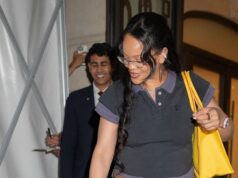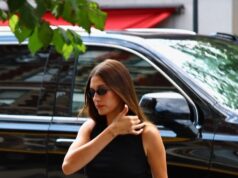It all unfurled over the course of about a month. In August 2010, Lady Gaga became the most-followed person on the platform we then called Twitter. Not long after, she was beamed into the homes of 11.4 million MTV viewers during the VMAs, wearing 35 pounds of raw flank steak. Over the next couple of days, the app made a critical update: For the first time, photos and videos could be embedded in tweets, and new posts began to populate the feed via an addictive, slot machine-style feature, now known as the “infinite scroll.” It buoyed conversation about the meat dress, already one of the most provocative sartorial creations ever to infiltrate popular culture, and made Gaga a trending topic for over a week.
Suddenly, every camera was a potential path to virality, every red carpet an arms race for attention. Few took better advantage of this fact than the era’s pop stars, who flooded the 2010s with well-timed public reveals of their baby bumps, shocking hair transformations, and hot-button accessories. But these days, virality is exhausting, and the pendulum is swinging in a different, though perhaps not entirely opposite, direction.
Think back to last Halloween and its parade of replicas: Charli XCX, Sabrina Carpenter, and Chappell Roan. The costumes didn’t always crib the same outfits—nothing so singular as the meat dress—but they each pulled from a common well. On every Charli: black tights, wraparound shades, a touch of Brat green. Each Sabrina: flushed cheeks, boudoir pastels, a bouncy blonde blowout equal parts Dolly Parton and Matilda Djerf. And for Chappell: a tumble of fiery-red curls, a prom dress, and a full face of makeup meant to straddle the line between drag queen and rodeo clown. Not until seeing iteration after iteration did I notice the clarity and consistency of each style, let alone how reminiscent they felt of certain aesthetics that have taken hold on TikTok—the apparent descendants of indie sleaze, coquettecore, and clowncore, respectively.
By now, these digital-native aesthetics are standard nomenclature, at least for the chronically online—each “core” a keyword to enable the search and retrieval of related images. Unlike traditional trends, aesthetics don’t always change seasonally. They exist simultaneously, laying roots that fan out, intertwine, and proliferate.
As social psychologist Anni Sternisko, PhD, explains, “TikTok’s aesthetic explosion represents a digital-age solution to a fundamental identity challenge: finding a way to be both part of something bigger and uniquely distinct.” Being part of a group that feels special scratches both itches, reconciling these conflicting psychological needs. An aesthetic, like a zodiac sign or Myers-Briggs type, affirms your unique personality while nestling you in a tribe that you can exit without major social costs. No one feels betrayed if you switch from “balletcore” to “blokecore.” (Though they might if you change from “skater” to “prep”—just ask Avril Lavigne.) But Sternisko warns, “While this fluidity allows for greater freedom in identity expression, it may also result in a less stable sense of group belonging.”
That’s where the pop girlies come in. When aesthetics and fandoms merge, the visual signifiers come alive, supercharged with the artists’ personalities. According to Mia Jacobs, youth fashion strategist for the trend forecasting company WGSN, the Brat aesthetic resonates with Gen Z not because they’re big fans of a specific brand, but because it “aligns with their values—rejecting perfectionism, embracing chaotic hedonism, and resisting societal pressures.” It’s not just a wine-stained tank top, it’s a symbol of emotional complexity. In Carpenter’s case, it’s not just a chiffon teddy, it’s an emblem of sexual agency. (Just in case the lyrics about fuzzy handcuffs went over your head.)
The breakneck visual shifts of Gaga’s The Fame Monster era may have held focus in the early days of infinite scroll, but social media today is even more saturated and cacophonous. The extreme still wins the moment, but lately, sustained attention is only granted when it’s paired with consistency and, ideally, some mythology to unpack. Aesthetics, with their cartoonish reliability and associations, accomplish all of the above.
With nods to clowncore and “trailer park princess,” Roan spins her biography into lore: a reappropriation of homophobic slurs; a celebration of her queerness; a recounting of her financially strapped 20s, when she subsisted on odd jobs; and the “Princess” tramp stamp that inspired her hit album title. For Doechii, it’s not just “prep” or “office siren,” it’s visual shorthand for her musical project: a thoughtful, buttoned-up MC who’s tapped into historical context as a student of hip-hop. Meanwhile, Beyoncé’s Cowboy Carter style, all chaps and ten-gallon hats, is “the yeehaw agenda” made manifest, an inescapable reminder of her album’s themes: that Black musicians are integral to the past, present, and future of country music; and that America warrants both celebration and critique.
Characters and alter egos in pop music are nothing new, but these aesthetics carry with them whole catalogs of references. A signature look is a seductive marketing framework that sparks obsession and conversation as fans dissect its allusions. But it forces a bit of flatness, too—as though caricature alone indicates an artistic statement, and anything less is unintentional or, worse, invisible. So what does it mean for this wave of artists to lean into aesthetics so persistently? A fear that subtlety or new associations might muddle the message? Or an acknowledgment that, given our dwindling attention spans, legibility is granted only to the most extreme, recognizable representations of self?
One thing that’s often missed about the meat dress: It was a political statement. “If we don’t fight for our rights, pretty soon we’re going to have as [many] rights as the meat on our bones,” Gaga said after the awards. But you wouldn’t know just by looking at it. Or by reading most of the commentary it inspired.
This story appears in the May 2025 issue of ELLE.
GET THE LATEST ISSUE OF ELLE









